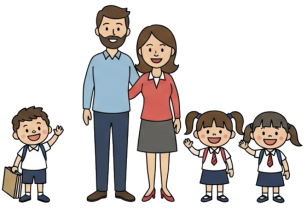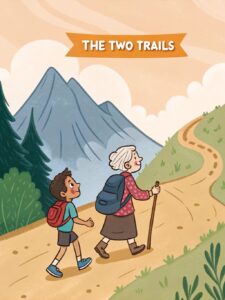
Question More, Action Knowledge.
Remember, at QMAK, we don’t just teach; we empower. We don’t just inform; we inspire. We don’t just question; we act. Become a Gold Member, and let’s unlock your child’s full potential, one question at a time.

There once was a boy named Theo who loved adventure but didn’t love challenges. Whenever he faced something difficult, he’d often look for the quickest, easiest way around it.
One summer, Theo went to visit his grandmother who lived in a small house near the mountains. On his first morning there, Grandma suggested they hike to Blueberry Hill.
“There are two trails we can take,” Grandma explained, spreading out a map on the kitchen table. “This one is called the Riverside Path. It’s flat and easy, but it takes three hours to reach Blueberry Hill.”
“And this one?” Theo asked, pointing to a dotted line that went straight up the mountain.
“That’s the Forest Climb. It’s steep and challenging, with some rocky sections to navigate. But it only takes one hour to reach the top,” Grandma said. “Which would you prefer?”
“The Riverside Path, definitely!” Theo replied without hesitation. “It’s longer, but it’ll be easier on my legs.”
Grandma smiled. “I thought you might choose that one. The Riverside Path is what we call ‘the path of least resistance.’ It’s the easy choice, but not always the best one.”
As they walked along the gentle riverside trail, Theo noticed they were barely getting any closer to Blueberry Hill, even after an hour of walking.
“This is taking forever,” he sighed. “And we’re still so far away!”
“We could try the Forest Climb tomorrow,” Grandma suggested. “Sometimes the harder path gets you where you want to go much faster.”
“But it’s so steep,” Theo protested. “I’ll get tired and sweaty.”
“True,” Grandma nodded. “But think about how you’ll feel when you reach the top. Which path would your future self thank you for taking?”
The next morning, to Grandma’s surprise, Theo announced he wanted to try the Forest Climb.
“I’ve been thinking about what you said,” Theo explained. “The easy path yesterday took so long that we only had a little time to enjoy the blueberries before heading back. Maybe the hard path is worth it.”
The Forest Climb was indeed challenging. There were steep sections where Theo had to use his hands to help climb, and rocky parts that required careful stepping. Several times, Theo wanted to turn back, but Grandma encouraged him.
“When you feel like giving up,” she said, “that’s usually a sign you’re growing stronger.”
When they finally reached the top of Blueberry Hill, Theo was tired and sweaty, just as he’d feared. But he also felt something new – a sense of accomplishment that bubbled up inside him like fizzy soda.
“We made it!” he exclaimed, looking at the incredible view. “And we still have almost the whole day to spend up here!”
While they picked blueberries for a pie, Grandma told Theo about other “paths of least resistance” in life.
“Sometimes it’s choosing video games instead of homework,” she explained. “Or eating candy instead of vegetables. Or quitting when something gets hard instead of pushing through. The easy choice feels good in the moment, but doesn’t get us where we really want to go.”
“Like how watching TV is easier than practicing basketball,” Theo said thoughtfully, “but it won’t help me make the school team.”
“Exactly,” Grandma smiled. “The path of least resistance rarely leads to our biggest dreams.”
On their way back down the mountain, Theo noticed something interesting.
“The way down is much easier than the way up,” he said.
“Yes,” Grandma agreed. “And there’s a lesson in that too. Once you’ve done the hard work of climbing up, many things that seemed difficult before become easier. The strength you build on the challenging path helps you in ways you might not expect.”
For the rest of his visit, Theo practiced choosing the harder but more rewarding path. He helped Grandma with difficult chores in the garden instead of playing his handheld game. He worked on a challenging puzzle instead of watching cartoons. He even tried new vegetables that didn’t look appealing at first.
Each time he chose the more challenging option, that fizzy feeling of accomplishment returned, growing stronger each day.
When it was time to go home, Theo gave Grandma a big hug.
“Thank you for teaching me about the path of least resistance,” he said. “I think I’ll try to avoid it more often.”
Grandma smiled. “Just remember, it’s not about always choosing the hardest way. It’s about recognizing when you’re choosing something just because it’s easy, and asking if that choice will really take you where you want to go.”
Back at school that fall, whenever Theo found himself automatically reaching for the easiest option, he would remember Blueberry Hill. He’d pause and ask himself, “Is this the Riverside Path or the Forest Climb? And which path will my future self thank me for taking?”
By choosing the Forest Climb more often than not, Theo discovered that what once seemed impossibly difficult eventually became just another trail he knew he could conquer.
The positive messages include:

Remember, at QMAK, we don’t just teach; we empower. We don’t just inform; we inspire. We don’t just question; we act. Become a Gold Member, and let’s unlock your child’s full potential, one question at a time.